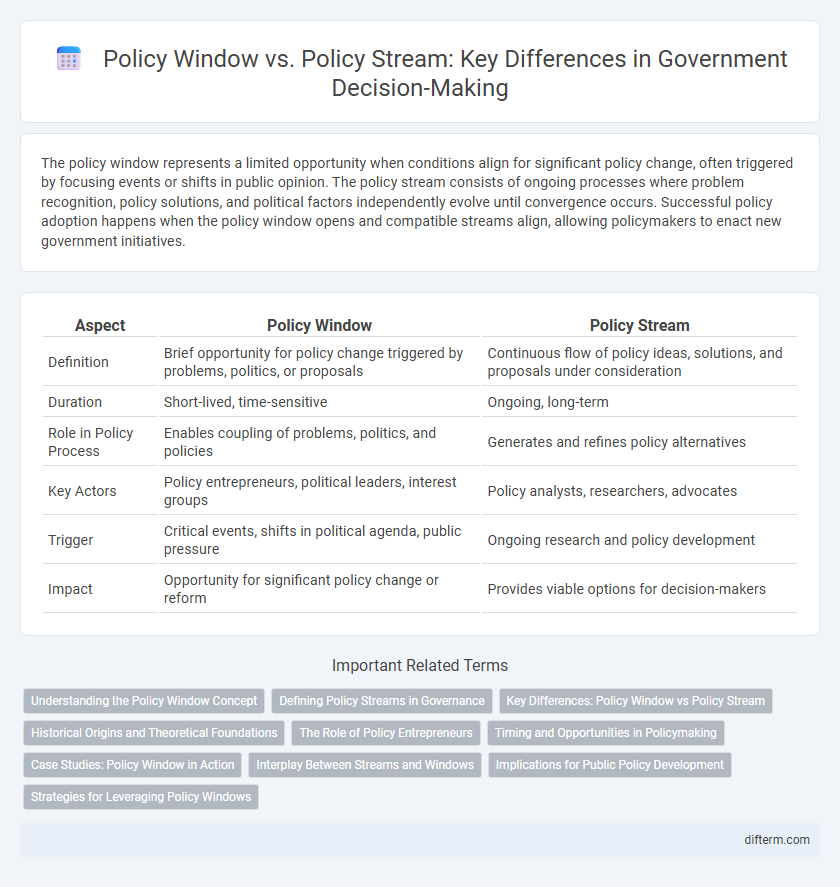The policy window represents a limited opportunity when conditions align for significant policy change, often triggered by focusing events or shifts in public opinion. The policy stream consists of ongoing processes where problem recognition, policy solutions, and political factors independently evolve until convergence occurs. Successful policy adoption happens when the policy window opens and compatible streams align, allowing policymakers to enact new government initiatives.
Table of Comparison
| Aspect | Policy Window | Policy Stream |
|---|---|---|
| Definition | Brief opportunity for policy change triggered by problems, politics, or proposals | Continuous flow of policy ideas, solutions, and proposals under consideration |
| Duration | Short-lived, time-sensitive | Ongoing, long-term |
| Role in Policy Process | Enables coupling of problems, politics, and policies | Generates and refines policy alternatives |
| Key Actors | Policy entrepreneurs, political leaders, interest groups | Policy analysts, researchers, advocates |
| Trigger | Critical events, shifts in political agenda, public pressure | Ongoing research and policy development |
| Impact | Opportunity for significant policy change or reform | Provides viable options for decision-makers |
Understanding the Policy Window Concept
The policy window refers to a limited opportunity when conditions align, enabling policymakers to introduce and advocate for new policies effectively. It is a critical moment in Kingdon's Multiple Streams Framework where the problem, policy, and political streams converge, allowing for significant policy change. Recognizing and leveraging the policy window can accelerate decision-making and promote timely government action.
Defining Policy Streams in Governance
Policy streams in governance refer to the continuous flow of ideas, issues, and solutions that circulate within the policymaking environment, influencing agenda setting and decision-making processes. These streams typically encompass problem recognition, policy proposals, and political conditions, which must align for effective policy change to occur. Understanding the dynamics and interactions within policy streams allows governments to anticipate policy opportunities and optimize strategic interventions.
Key Differences: Policy Window vs Policy Stream
Policy windows refer to specific opportunities when conditions align for significant policy change, often triggered by crises, political shifts, or public attention, enabling the adoption of new policies. Policy streams represent the continuous flow of problem identification, policy proposals, and political factors that independently evolve over time, shaping the policy landscape. The key difference lies in timing and opportunity: policy streams exist persistently, while policy windows are temporary openings that allow policy streams to converge for actionable reform.
Historical Origins and Theoretical Foundations
The concept of the Policy Window originates from John Kingdon's Multiple Streams Framework, emphasizing moments when policy change becomes possible due to the convergence of problem, policy, and political streams. The Policy Stream refers to the pool of ideas and solutions developed by experts and advocates over time, grounded in bounded rationality and incrementalism theories. Both concepts are rooted in the historical evolution of agenda-setting and decision-making theories within political science and public policy analysis.
The Role of Policy Entrepreneurs
Policy entrepreneurs play a crucial role in aligning the policy stream with emerging problem recognition during a policy window, effectively shaping agenda-setting and facilitating policy change. Their strategic use of framing, lobbying, and coalition-building helps synchronize political, problem, and policy streams, increasing the likelihood of successful policy adoption. By leveraging windows of opportunity, policy entrepreneurs can accelerate reform in government by coupling solutions with receptive political conditions.
Timing and Opportunities in Policymaking
The policy window refers to limited periods when political conditions align, creating a strategic opportunity for new policies to be introduced and gain traction. In contrast, the policy stream consists of ongoing, separate processes involving problems, solutions, and political circumstances that must converge for change to happen. Effective policymaking depends on the timely alignment of these streams within the policy window to capitalize on opportunities for reform.
Case Studies: Policy Window in Action
Policy windows represent critical moments when political conditions align, enabling significant policy change, as demonstrated by Kingdon's analysis of healthcare reform in the United States during the 1990s. Case studies reveal how focusing events, shifts in public opinion, and political leadership converge to open these windows, allowing policy entrepreneurs to push solutions from the policy stream into adoption. Understanding the dynamics between the policy stream of ideas and the sudden opening of policy windows is essential for analyzing successful government interventions and reform outcomes.
Interplay Between Streams and Windows
The interplay between policy windows and policy streams is critical in government decision-making processes, where policy windows represent opportune moments for change while policy streams encompass ongoing problem, policy, and political factors. Successful policy adoption often occurs when these streams align and a policy window opens, allowing policymakers to push innovative solutions. Understanding this dynamic enables governments to effectively seize moments for reform by synchronizing problem recognition, viable policy alternatives, and political will.
Implications for Public Policy Development
The Policy Window represents strategic opportunities for policy change when problems, policies, and political conditions align, driving significant shifts in public policy development. The Policy Stream encompasses the continuous flow of policy ideas and proposals that accumulate over time, influencing what solutions gain traction during these windows. Understanding the interaction between Policy Windows and the Policy Stream is crucial for policymakers to effectively navigate timing, public support, and political will, maximizing the implementation of impactful policy reforms.
Strategies for Leveraging Policy Windows
Policy windows offer critical opportunities for enacting significant government reforms by aligning problem recognition, viable policy solutions, and political will. Strategies for leveraging policy windows include preparing evidence-based proposals beforehand, building coalitions with policymakers and stakeholders, and timely advocacy to capitalize on shifts in political climate. Effective use of policy streams requires continuous policy development to ensure readiness when these brief windows for change appear.
Policy Window vs Policy Stream Infographic

 difterm.com
difterm.com